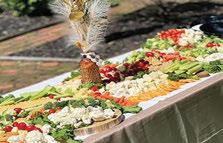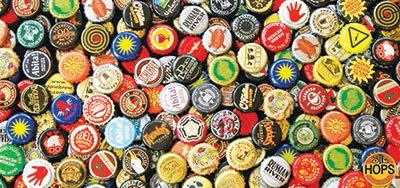




Local breweries offering fun time, creative beers.......2
Central Pennsylvania residents go hog wild for pig stomach...............................................................11
Williamsport Sun-Gazette
PUBLISHER
John Leeser jleeser@sungazette.com 570-326-1551
ADVERTISING DIRECTOR
John Leeser jleeser@sungazette.com 570-326-1551
Lewistown Sentinel
PUBLISHER
Ruth Eddy
reddy@lewistownsentinel.com 717-248-6741
ADVERTISING DIRECTOR
Matt Bolich mbolich@lewistownsentinel.com 717-248-6741
Lock Haven Express
GENERAL MANAGER
Jordan McCloskey jmccloskey@lockhaven.com 570-748-6791
ADVERTISING DIRECTOR
Jordan McCloskey jmccloskey@lockhaven.com 570-748-6791
PUBLISHER
Dan Slep
dslep@altoonamirror.com 814-946-7411
ADVERTISING DIRECTOR
Tracy Brooks tbrooks@altoonamirror.com 814-949-7021
By Conner Goetz cgoetz@altoonamirror.com
Almost four years after the start of the COVID-19 pandemic, the Blair County brewing industry is regaining momentum and looking toward a brighter future after standing on shaky ground financially for the last several years.
When Stefano Ferrari moved from the sun-baked Milan countryside to Bedford in 2007, he came with a vision.
After meeting his now ex-wife, Sarah Ferrari, while she was studying abroad in Italy in 2001, the couple eventually decided to return to Sarah’s hometown to pursue Ferrari’s vision, opening the original LIFeSTYLE location in Bedford in 2007.
“They decided to take this big leap, and move here together to open
LIFeSTYLE,” younger brother and co-owner Davide Ferrari said.
The business, in its original configuration, was a high-end gourmet store, specializing in hard-to-find culinary products from Italy.
In 2008, a series of highly popular cooking demonstrations hosted by Stefano sparked LIFeSTYLE’s expansion into fine dining and now offers weekly four- and five-course handmade Italian fare.
While the brothers are from Magenta, a small village west of Milan, they strive to showcase different cuisines from across Italy.
“Back then, especially in Bedford, there was not this knowledge of high-end products,” Davide Ferrari, 36, said. “So they had this opportunity to do something really new and really cool.”
The name — which is an acronym for “Living Italian Food and Style” -— speaks to the immersive quality the Ferrari family envisioned for
their store, according to Ferrari.
In January 2023, two investors from Altoona approached the Ferrari brothers with an offer to expand north into Blair County.
“They saw how authentic, how special this atmosphere is, and basically we wanted to do something to serve a larger community — such as Altoona,” Ferrari said.
Alongside their new business partners, the Ferraris began renovating the Seventh Avenue property that would become LIFeSTYLE ALTUS, a brewpub spin on their Italian fine dining concept.
For the new location, which opened in September 2023, the brothers created a new brand, Wild Brewing Co., to produce a selection of home-brewed beers for inhouse consumption and regional distribution.
Brewmaster Ryan Bouslough, a Hollidaysburg native, was recruited from Pittsburgh to return home
and lead Wild Brewing, which now makes more than 14 beers, eight of which are offered at their Bedford location.
“Our brewmaster, Ryan, is excellent at everything he does,” Ferrari said.
In addition to American staples such as IPAs and sours, Wild offers a selection of European specialties like Belgian ale, Belgian tripel and honey saison — a recipe from northern France that Bouslough produces using honey imported from Sicily.
Across all their beer varieties, Ferrari works closely with Bouslough to ensure every brew is “a really balanced product,” not overbearing with one particular flavor or another.
His personal favorite is Wild’s Belgian blonde ale.
With Wild Brewing’s canned beers, Ferrari said they have big plans for wider distribution. Their
Continued on Page 4



hazy IPA is already available in more than 15 central Pennsylvania beer retailers.
“The brand is getting to be really recognizable, but not only in the local community,” Ferrari said.
And although their business is planning to grow beyond the confines of central Pennsylvania, the Ferrari family is still firmly grounded in their new home.
“We love Bedford County,” Ferrari said, “because it gives us a chance to actually enjoy what we built and what we have.”
When Shannon Poust moved to Tyrone with her husband Rob in 2017, she felt like there was something missing in the community.
“We realized this town was really lacking somewhere to go and get a coffee, or even take your laptop and hangout, or get a good craft beer,”
Poust, 35 said.
At the time, Poust was working at Penn State and living comfortably.
“I loved my job, but it was just one of those ‘you know what, I’m going to take a leap of faith,’ and open something up,” the State College native said.
The Brew opened the coffee bar portion of the business in June 2019, and immediately had ideas for expansion.
“We noticed a lot of similarities between small shop coffee drinkers and craft brewery drinkers, it’s a similar demographic,” Poust said. “So we said ‘why isn’t there somewhere that has both?’”
While this was a promising concept, it created its own set of hurdles, since the state Liquor Control Board did not have guidelines in place for a prospective cafe like The Brew.
“The state didn’t really know what to do with us, because we were really the first of our kind,” Poust said.
In Pennsylvania, obtaining a liq-
uor license can be difficult, according to Poust, since the license itself can cost over $15,000 and comes with a plethora of legal requirements for how the business must operate.
“The state doesn’t make it easy for anyone to sell, consume or make alcohol,” Poust said,
Despite their lack of capital to proceed with the licensing process, Poust did not give up her vision.
“We actually were approached by University Wine Company about being a satellite location for them,” Poust said.
Although her business is not centered around wine, the partnership created a legal “loophole,” allowing The Brew to serve alcohol under the University Wine Company license, according to Poust.
This arrangement stipulates that The Brew cannot serve takeout beer, and can only stock Pennsylvania-produced alcohol, which works out just fine for Poust.
As a casual beer hobbyist of al-




most 15 years, Poust’s initial interest grew when she met her now-husband, Rob, in 2013, who shares her affinity for the hoppy beverage.
“We liked to travel, so we made it a hobby of ours to travel specifically to breweries,” Poust said.
She keeps her collection of souvenir pint glasses from around the state on a ledge that traces the upper wall of The Brew, akin to a trophy hunter’s display of taxidermied wildlife.
After cementing the relationship with University Wine Company, Poust began to develop the beer side of her business.
“Pennsylvania’s beer industry is wild,” Poust said. “There are just so many breweries and so many beers to choose from.”
Poust prides herself on offering a selection of brews from Philadelphia to Pittsburgh.
The Brew usually features 10 different breweries on tap, with up to
Continued on Page 6















National Root Beer Float Day is celebrated each year on August 6. The day is a great chance to dig into a frosty sensation, but root beer floats are ideal just about any time of year.
A traditional root beer float is made by pouring bubbly root beer over vanilla ice cream. Frank J. Wisner, owner of Colorado’s Cripple Creek Brewing, is credited with creating the first root beer float on August 19, 1893. Wisner concocted the drink after the snowy peaks of Colorado’s Cow Mountain reminded him of ice cream floating in soda. So he combined the two and called the beverage a “Black Cow.” Most people now refer to it as a root beer float
Root beer floats can be made with any variety of root beer. Some of the popular choices include Barq’s, Dad’s, Mug, IBC, A&W, Stewart’s, and Dr. Brown’s. Take a tall glass designed for malted drinks or ice cream shakes and spoon in two scoops of vanilla ice cream. Then pour in enough root beer to submerge the ice cream. Top with whipped cream and a cherry.
A classic root beer float can’t be beat, but those looking to create a “Float Bar” for a special party dessert offering, can whip up many different combinations of ice cream and beverages. Here are a few ideas.
• Make the root beer floats pint-sized with
root beer float shooters.
• Swap vanilla ice cream for chocolate and have an even richer root beer float.
• Use cherry cola and vanilla or black cherry ice cream for a sweet surprise.
• Pair orange soda with vanilla ice cream and make a creamsicle in a cup.
• Pour your favorite iced coffee beverage over coffee or chocolate ice cream for a mocha-style treat.
• Grape soda and peanut butter ice cream creates a drinkable version of a PB&J sandwich.
• Recreate the appeal of chocolate-covered strawberries with strawberry soda poured over chocolate ice cream.
• Piña coladas take on new life when pineapple soda and cream of coconut are mixed with scoops of vanilla ice cream. Add a dash of rum for an adult version.
• For another spirited concoction, skip the ice cream and use lime-flavored sherbet and tequila for a margarita-inspired treat.
• Chocolate soda or Yoo-hoo Chocolate Drink can be added to marshmallow-flavored ice cream and topped with a dusting of graham cracker crumbs for a s’mores-flavored float.
The possibilities are endless when creating floats inspired by the original root beer float.
Rich flavors, familiar foods and large portions are hallmarks of country cooking. However, ingredients may vary by region, and the backgrounds of the people living in these parts of the country also may contribute to some unique recipes on traditional favorites. The following are five types of country cuisine and the foods associated with each tradition.
Creole and Cajun cooking have similar influences but are not entirely the same. Creole originated in Louisiana and uses cooking techniques from Spain
and France, but spices and ingredient combinations passed down from African cultures and Native Americans. Gumbos and bread
puddings are popular Creole dishes. Cajun cooking originated when French Canadians migrated to Southern Louisiana in the mid-1700s. Popular Cajun dishes incorporate crawfish, alligator and frog.


The low country is the South Carolina coast. Low country cuisine utilizes seafood taken fresh from the coastal waters to make savory dishes that are similar to Creole and Cajun dishes. Rice, shrimp, grits, and okra are popular ingredients in low country cooking.
Those in the central Appalachian mountains have a cuisine all their own that spans several different states. As farms are prevalent in these areas, farmfresh foods that are homegrown are quite common. Chicken and dumplings, chili beans, cobblers, biscuits and gravy, and wild game all are part of Appala-
chian cooking.
Soul food gained steam during the 1960s when Black Americans aspired to honor their ties to country cooking as well as their heritage. Comforting and familiar dishes include collard greens, candied yams, fried chicken, sweet potato pie, and macaroni and cheese. These dishes are universally enjoyed by people of all races and cultures. And as Black individuals moved out of the South, they brought their meals and cooking styles with them.
Country cooking is unique, flavorful and comprised of the foods and techniques honed by people from many cultures.
20 more represented in canned beers. Her personal favorite of the current rotation is the hard cider from Arsenal Cider House in Allegheny County.
“A lot of these beers you can’t get outside the brewery because they don’t distribute,” Poust said, “so it’s become our little niche.”
Poust bases her decision on what to offer based on a combination of seasonal availability, customer requests and her own palette.
“Like sour beer had its time for a few years, but that’s fizzling out, now we’re seeing more people want light beer or light lagers, something a little more drinkable,” Poust said.
While sours and hazy IPAs were the predominant choice for the past few years, now customers are asking for traditional IPAs and west coast IPAs, according to Poust.
The key, Poust said, to staying ahead of the curve is careful planning and maintaining relationships with breweries, saying it’s important to have an idea of what brews will be available in different seasons.
“You can’t predict anything in this industry,” Poust said, “but we try really hard to think ahead.”
Now, nearly five years into her career, Poust is getting a better sense of the industry.
“We notice a lot of similarities between what people are requesting and what our personal palettes want now,” Poust said.
According to Poust, this relationship between brewery, distributor and customer forges a very “tightknit” community within the local beer industry.
“In breweries, in the trends they’re seeing, they’re going to brew what they think … is going to sell,” Poust said, “but they’re also asking us ‘what are you selling?’ because every location — here, Altoona, State College, Harrisburg — is going to have different beer style preferences.”
A chance visit from a busload of thirsty people in 2019 was the unlikely catalyst for Levity Brewing Co.’s expansion in Altoona, laying
the groundwork for a promising future.
“Levity got started with three friends brewing beer in a garage in Indiana, Pennsylvania,” Altoona pub operations manager Rob Poust said.
The three friends — Jared Herman, Erich Walls and Luke McKelvy — met in college and bonded over their love for beer and brewing, but didn’t realize that their efforts had potential beyond the garage.
In January 2016, the trio opened the original taproom and brewery in Indiana after a positive response from friends.
“They all decided to make career changes at that point and invest their time and energy into Levity,” Poust, 43, said.
After the success of the Indiana location, word spread quickly.
“Eight or nine years ago in the industry, things were just beginning to take off,” Poust said. “People were very excited and receptive to the concept since there weren’t any other craft breweries in Indiana.”
Poust first got involved with the business after his wife, Shannon, hosted a tap-takeover event for Levity at The Brew in 2020, where Rob met the ownership trio.
“About a year and a half ago, I reached out,” Poust said. “I was looking for a career change and I wanted to get more embedded in the beer industry.”
After messaging Walls, Poust met him for a meeting the next day and decided to make the change from his previous career of construction and house flipping.
“I always had a love for craft beer and the camaraderie with other breweries,” Poust said.
After word of its popularity spread, City Mayor Matt Pacifico played an integral role in bringing the second Levity location to 11th Avenue in Altoona.
“We wanted to be in Altoona, they wanted us in Altoona,” Poust said.
“So Matt and a group of folks chartered a bus full of business owners and council members from Altoona to Indiana, and they hung out all night … and that’s what solidified it for us.”
Continued on Page 7















the pipeline,” Poust said. “We want to contribute to the town of Altoona where we can. That’s one of our big goals for Levity.”
Poust said he is excited for their Summer Fest event in June, where they close the street and open up Heritage Plaza for vendors and live music.
Since its doors opened in 2021, Spring Dam Brewing Co. has been a bright spot in Roaring Spring, utilizing a combination of innovative events and familiar charm to draw crowds.
The brewery is the passion project of a couple — Anita Baker and Mike Keith — who almost single-handedly initiated, and won, a referendum overturning Roaring Spring’s prohibition on alcohol sales which had stood since 1920.
The referendum passed with a 65to-35 margin of support in 2019.
Spring Dam was a shared vision for the couple.
Baker and Keith met on Ocracoke Island in North Carolina in 2017 on St. Patrick’s Day and bonded over a love for brewing.
As a Roaring Spring native, Baker said she had wanted to bring quality craft beer to the area for a long time.
According to Baker, the historic East Main Street building used to be a newsstand before being purchased by the couple.
Converting the space into a brewery was challenging at first, Baker said.
“Thankfully, my son is a contractor and he got in here and did a lot of work for us, and that was right when COVID hit,” Baker said.
The pandemic gave them an opportunity to take their time with construction, making sure every detail was perfect.
During renovations, the original stone walls were uncovered and the
Continued on Page 8
After the fateful bus trip in 2019, it was a gradual process to reach the “grander reopening” in December 2022, according to the Levity website.
“The owners looked at several different locations, and settled on 11th Avenue because of the history down here,” Poust said.
Levity Altoona now occupies a lofty building from the early 20th century, complete with original brick walls and a functional garage door facing the street.
“Being a part of the true, historic downtown of Altoona was really appealing to us, and this seemed like a great spot,” Poust said.
Before the current ownership, the building was used for a teacher supply store, dentist office, jewelry store and clothing retailer at different points.
At first, Levity operated a small taproom in the front of the two-story building, but closed for a year due to the pandemic, which gave staff an opportunity to complete the re-
mainder of the renovation process — adding a kitchen and five-barrel brewhouse.
Once the Altoona taproom finally opened, the response from the community was strong.
“Especially after COVID, people just wanted to get back out and do stuff,” Poust said. “People were excited.”
Since he came on board, Poust has been trying to increase the brewing operation at the Altoona location.
According to Poust, Levity is well known for its hazy IPA beers, particularly Haze Frehley, which won a gold medal at the 2023 in the under 7.5% IPA category.
Their flagship beers, Poust said, are their Tang Glider series of kettle sours.
Levity also offers a variety of IPAs, lagers and pilsners, in addition to their Single Prop-series of limited-production offerings.
Poust’s personal favorite is the eighth anniversary stout, which was a 13.1% ABV barrel-aged bourbon stout.
“We have a couple other things in



























ceilings were raised. The original solid wood counter was also raised off the floor to serve as a bar adjacent to the seating area — complete with tables fashioned from converted barrels.
“The only thing left here was this (counter). Everything else we tore out,” Keith said.
Baker decided on a speak-easy theme for the new establishment, both to commemorate the 100th anniversary of prohibition and the successful referendum in 2019.
According to Baker, reopening at 25% capacity in January 2021 “actually worked in our favor,” since it allowed the duo, who had limited prior experience in the restaurant industry, to learn how to run the brewery.
“I think the pandemic made everybody’s world smaller again,” Baker said. “And everyone was forced to stay home, and suddenly ‘local’ became this big thing then.”
For Keith, who manages the brew-


ery side of the business while Baker manages the restaurant side, it is a continuous learning process.
Keith began his brewing journey when he lived on Ocracoke Island, where he helped his friend Garick Kalna build his own brewery in 2017.
“He asked me if I wanted to learn how to brew, and I said sure,” Keith said.
Since then, Keith and Kalna remain close friends, with Keith occasionally calling Kalna for his input on a potential beer recipe or brewing decision.
“We go down there and he critiques our beer,” Baker said. “We call him our sensei.”
Spring Dam now produces an assortment of different brews with an in-house three barrel brewing system, including sours, hazy IPAs, Czech pilsners and American lagers, as well as more off-the-beaten-path options like vanilla porters and milk stouts.
“We don’t have a ton, but they’re very popular, and people love them,”
Keith said.
One of their signatures is their Benny’s Mexican lager, which uses flaked corn, an unheard of grain in many traditional American beer styles.
For Keith, his personal favorite is the Roy Haze IPA, while Baker prefers the Benny’s.
In February, Spring Dam brewed their 100th batch since they opened.
“I’m pretty novice at this, but the water makes my job a lot easier,” Keith said.
According to Baker, Spring Dam’s famously high-quality water is “a big plus” for their beer.
“There’s a lot of calcium in this water, and it’s great,” Keith said.
Spring Dam is also known for its food, which goes beyond standard bar nuts and snacks.
“The kitchen is all homemade food, we don’t buy anything frozen and serve it,” Baker said.
She offers a wide variety of dishes depending on the day of the week, including pancakes, wings and crab-
cakes.
The brewery features live music every Friday and Saturday and hosts an open mic night once a week to highlight local artists, according to Baker.
“I got interested in starting a brewery because I love live music, so we’re definitely known as a hotspot for music,” Baker said.
An important factor to Spring Dam’s success, according to Keith, is the welcoming community of other brewers in south-central Pa.
“There’s a lot of breweries around here, and we help each other out a lot,” Keith said. “We have a lot of friends in the brewing industry.”


















Backyard barbecue season is starting to heat up. Although many people grill all year long, grilling season kicks into high gear in spring and summer.
Burgers will always be quintessential grilling fare. It should come as no surprise that the month of May is National Hamburger Month. That’s likely due to Memorial Day weekend — which many view as the unofficial start of summer — being one of the first times of the year people begin grilling burgers. Despite burgers’ popularity, it’s easy to make mistakes when preparing them. These tips can help anyone build a better burger.
Buying ready-made ground meat (of any variety) is taking a gamble because you don’t know when it was ground, how many animals it came from or how it was handled. By freshly grinding the meat at home you will have greater control over the cut of meat and the fat content. Personally ground meat will be fresher, especially when you get nice cuts of meat directly from your local butcher. Top chefs suggest dicing cold meat into chunks and freezing for about 10 minutes prior to grinding for the best results.
For the most juicy, flavorful burg-

er, you’ll want a ratio of 80 percent meat to 20 percent fat. Some people like to eat lean, but with a burger, the fat will be necessary and it’s better to select leaner meats for other dishes.
Handling the burger patties too much can lead to dense, tough burgers. Gently shape the burgers into round, 1-inch thick, flat discs. To prevent the burgers from rounding in the middle during cooking, press a dimple with your thumb in the center of the patty to help it cook evenly. It’s a smart idea to weigh each patty to ensure uniformity of size and even cooking.
Don’t add salt early on
Salt added to the ground meat before it’s shaped can draw the liquid out of the meat, leaving a dry burger behind. Sprinkle salt sparingly while it is cooking for flavoring.
Most health authorities recommend not leaving any pink meat in a burger made from ground meat. According to BBC Good Food, burgers can be cooked for 5 to 6 minutes on each side for medium and 8 to 9 minutes per side for well done. For the best results, use a food thermometer to check internal temperature. The USDA says ground meat, whether it’s pork, veal, beef, or lamb, should be cooked to 160 F
The cooking resource Serious Eats debunked the myth that burgers should only be flipped once. Flipping the burger repeatedly, as often as once every 15 seconds, encourages faster, more even internal cooking and can dramatically reduce cooking time.
Keep the patties separate
Let everyone build their own

burgers, as keeping the cooked meat away from the burger buns for as long as possible will reduce the chances of the juices making the buns soggy. Soft, squishy buns tend to make for good burger eating, as

they will not overwhelm the meat with too much crusty bread. The smell of grilling burgers is in the air. Ensure that every burger is a masterpiece by utilizing some important cooking tips.




By Matthew Bolich The Sentinel
If you made a list of foods that are both 1. Pennsylvania Dutch-specific and 2. considered “odd” or “gross” by some people, stuffed pig stomach would be near the top of that list. Scrapple might be in that same discussion, but pig stomach is just one of those dishes, that by virtue of its very name, elicits strong reactions. Just listening to a group discuss pig’s stomach and you’ll hear the same thing—‘I can’t get past the name.’ Honestly, the alternative name, hog maw, probably isn’t much better if you want make converts for this oft-reviled food. Maybe that’s why the dish is referred to by some as “Dutch goose” or “Susquehanna Turkey”, which sounds significantly more appetizing.

But in places like Mifflin and Juniata Counties, there are plenty of pig stomach fans who don’t care what you call it- they just know that it’s delicious. For many, this unique main course holds a special place among their food memories, as hog maw was a special occasion meal or a cherished family food tradition. When The Sentinel (a daily newspaper located in Lewistown, Pa.) published a Facebook post soliciting comments on the dish, our page was inundated with likes, shares and comments. There is an obvious passion in the Juniata Valley for this misunderstood meal.
Locals are high on this hog Ironically, pig stomach is really just a stuffed casing, much like sausage in a natural casing is made from intestine. Of course, hog maw casing
is much bigger than a typical sausage and has a less genteel name. Even those who don’t want to try the dish have to admit that what fills the stomach is pretty delicious- sausage, potatoes, onions and seasonings. For those who grew up with pig stomach, the meal holds a special place in their heart. Here are some of the comments from Sentinel readers on our Facebook page:
This was our Christmas Dinner for years. Our family tradition is we butcher pigs every year. At 57 I have spent at least 52 of these years perfecting every part of the craft. This tradition has been going on before I came along. And you can bet that this year the Saturday before Thanksgiving we will gather again and fire the kettles at 5 AM. And you can bet that the old ( original ) smoke house will get filled with fresh pork yet again. Pig stomach with fresh sausage, well, it’s simply the best. Brooks Gamble
Continued on Page 12




This meal brings back a lot of memories when my grandmother would butcher every year. Two of my favorite things about butchering were the kettle meat and saving the stomach for stuffed pig stomach. I have kept this meal a yearly tradition. I stuff with cabbage, diced potatoes, loose sausage and a box of sage stove top stuffing. I have discovered by adding the stove top stuffing. You don’t need any other spices and makes a great flavored stomach.
Sherryl Wagner
We’ve always had this at least once a year….I wouldn’t say that it is a tradition with us …..I just make it when we get hungry for it…I actually have one in my freezer and now after seeing this I may need to make it soon …Yum!!!
We like equal amounts of extra peppery sausage, potatoes in small cubes and chopped cabbage… plus just a couple grated carrots and some parsley…I make enough of this mixture depending on the size of the pig stomach to make it nice and full stitch it closed with kitchen twine or use tiny metal skewers..then into a roaster with a cup of water put the lid on and bake long and slow till it is nice and brown like your picture and what is not brown
to our

is very tender..
Mmmmm—Teresa O’ Neal
Passed down from my Grandma. Every family members birthday meal for generations. Hamburg, sausage, potatoes and cabbage.
– Kathy Woods
Yum! My mom would put cut up pork chops, sausage, potatoes, and chestnuts in ours. I could really eat some now!
– Marie Bingaman
My grandmother used to make it with smoked sausage and potatoes. She was very meticulous and diligent about cleaning them very well on butchering day. We used to have pig stomach dinner fundraisers back home at the Millheim Fire Hall back in the day. Always a huge hit! I love to make it occasionally just like she made it.
– Brad Wingard
I make this! Loose sausage, cubed potatoes & onion...My Mother always used cabbage...Delicious....
– Audrey Peters

Quite a few years ago, the Decatur Township Fire Company, located in Mifflin County, held a pig stomach fundraiser meal at the fire hall on US 522 North. There were many variations of the filling ingredients at that supper, and the comments from Sentinel readers support the idea that there is no uniform recipe to stuff a pig stomach. Cut into a hog maw and you could find cabbage (including sauerkraut), bread filling, hamburger, carrots, smoked sausage or other stuffing options. One of the things that makes pig stomach a special treat for many is that it’s not something you have all the time like spaghetti or hamburgers. It’s not a simple or quick preparation and for many families they may eat it only one time per year. But a restaurant on the border of Snyder and Juniata County has been serving up pig stomach for well over 25 years.
Cross the county line to go “high on the hog” Take PA-35 North from Mifflintown and you’ll eventually cross from Juniata to Snyder County in the town of Richfield. Coming from Juniata County, on the left hand side of the road, the County
Continued on next page

Contains wine sediments, a natural byproduct of the wine making process!
Usually thrown away, the antioxidant-rich grape seeds and skins are recycled and have a second life in our unique and effective skin care products.

Line Restaurant has been serving up home cooked meals and delicious desserts since 1968. And on the fourth Friday and Saturday of each month, this spot is known to dish up pig stomach platters for diners who want to get their hog maw fix.
Ronda and Chad Sheaffer, Richfield, have owned the County Line Restaurant since May 2022, and employ some 65 staffers throughout the year, including seasonal help. When they took over the restaurant, they already knew that pig stomach was a popular monthly special. Ronda

had worked at the County Line for 14 years in the early 2000’s, so she was aware that there were loyal customers for this unique platter.
The restaurant gets their pig stomachs from a local shop and Sheaffer says they plan for roughly 30-40 platters per weekend of the special. What gets stuffed into the County Line version of hog maw? “We use three types of sausage- smoked, regular and a smoked kielbasa,” she said. Potatoes, celery, carrot and onions also go inside the stuffing. Since it’s not a



family style meal, platters come as a hearty slice of the baked pig stomach with the option to have gravy with the entrée.
On the Friday that Sheaffer spoke with the Sentinel, Harry Leister, Harrisburg, was in for lunch and ordered the pig stomach special. Although he didn’t look it, Leister proudly declared he was 91 years of age, and that this wasn’t his first time enjoying the pig stomach at the County Line Restaurant.
It’s a safe bet that most people who make pig stomach have probably been preparing the dish for years and had the recipe handed down to them from family. But what if you want to try making this unique food? The first thing you need is a cleaned pig stomach, which would likely need to be ordered from a local butcher or meat shop. From there, you’ll need to decide what ingredients you’ll want to use for stuffing the hog maw. If you want to follow a recipe, there are online ones and even videos showing how to prepare the dish.
Many Pennsylvania Dutch cookbooks also have at least one hog maw recipe within them. The
Continued on page 14























books Pennsylvania Trail of History Cookbook and The Art of Pennsylvania Dutch Cooking both contain a fairly straightforward recipe that call for diced potatoes and fresh loose sausage. Most recipes call for onions, but any vegetables are optional based on preference. It helps to have a little bit of sewing knowledge also, since thread or twine is required to close both ends of the pig stomach.
The following is a recipe reprinted from the Mifflin County Bicentennial Cookbook that was published in 1989:
Filled Pig Stomach
Bread Cabbage
Onions Hamburger
Carrots Sausage
Celery Apples (optional)
Potatoes
Dice or break apart ingredients and mix together. Fill stomach, put in roaster with 2-3 cups of water and cook several hours at 350.
Linda Fisher, Lewistown
Pig Stomach recipe
Submitted by Melanie Hosler
Make sure pig stomach is clean, then soak in salt water overnight.
Cut up 5 lb potatoes
1 head of cabbage
1 bag of lima beans optional
1lb bonless ribs.
1 lb sausage
3 large onions
Salt and pepper ingredients, then mix together in a large bowl
Stuff the stomach, it will stretch out, make sure to fill all ends.
Tie up with string like string that is used to tie a chicken.
Place in roaster, add either water or chicken broth.
Bake at 350 for about 4 hours, well before it’s done, take the lid off and let it brown.
Save the broth to put over it on your plate.
Most people eat the top layer of stomach, since the ends are gummy, but some do eat that. My grandmother made pig stomach at least 3 times a year. One time I told her that I was so hungry for it that I could eat a whole one, so she actually put one on a meat plate and yes, I ate it. OMG, I was

Transportation for groups of all sizes!
Sedans, Vans, Sprinter Limos, School Buses & Motorcoaches
stuffed! Great memories.
– Contributed by Melanie Hosler
No matter where you stand on pig stomach, there is no doubt that it’s one of the most unique dishes with Pennsylvania Dutch roots. Whether you call it pig stomach, hog maw or Dutch goose, just remember that in Central Pennsylvania, all the pig is used but the squeal!



Millions of people are interested in brewing their own beer at home. Craft brewing may start as a hobby or curiosity, and once successful, turn into something individuals do again and again. While it’s possible to eventually make money by brewing, most people engage this hobby for the pride that ensues after sipping their own ales, pilsners and stouts and sharing them with friends and family.
Those ready to engage in home brewing will be happy to learn that there are plenty of resources available for getting started. Even with a simple set-up, it’s possible to brew a decent beer. Here are the items to consider.
• Brew pot: Home brewers will need something in which to boil the wort, which will eventually become the beer. This vessel should be made of aluminum, stainless steel or enamel-coated aluminum and be large enough to handle the size batch of beer.
• Fermenter: Fermenter vessels will hold the beer while it is going through the fermentation process. Food-grade plastic buckets or glass carboys are options. The fermenter should seal tightly to keep out air and microorganisms, but have a space for an airlock that will allow the carbon dioxide to escape.
• Tubing and siphon: A siphon and vinyl tubing is needed to rack the beer from one fermenter to the next or from the fermenter to bottles.
• Hydrometer: A hydrometer, according to Beer Tola, a resource on brewing and beverages, is a tool that measures the density of liquid, known as specific gravity. This helps one calculate when fermentation is complete as well as the alcohol content of the finished product.
Sanitation is essential when brewing, and all equipment needs to be sanitized correctly so that the beer is not introduced to microorganisms that can affect taste or even the fermentation process. Only the yeast used for fermentation should be present. Many experienced brewers say that sanitation is the most important part of the process. Brew shops sell specialized chemicals for sanitizing all equipment, but some home brewers also stand by boiling water for cleaning gear.
The basics of beer recipes include hops, grains, water, and yeast. When the hops and grains are boiled down, one has wort, which essentially is sugar water. The yeast will feed on this sweetened water to produce carbon dioxide through fermentation.
The beer-making process is one


any beer lover can explore. And with so many beer kits for sale with stepby-step instructions, any initial foray into brewing beer can be successful.











Even though pizza, wings and beer is a combination that has appeared on game day food tables seemingly since the dawn of organized sports, the nuances of beer open up the possibility for many other food-beverage combinations. Just as wine can complement a variety of different foods when the right combination of flavors is presented, so, too, can one’s favorite brew.
Craft brewers have opened the public’s eyes to a much wider array of beer styles than may be available at the local liquor store or supermarket. Below you can find some suggestions for beer and food pairings, courtesy of the Brewers Association.
• Blonde Ale: Match this ale with lighter food choices, such as chicken, salads, and light, nutty cheeses.
• India Pale Ale: The hoppy forward flavor of IPAs makes these popular beers a good pairing

with strong, spicy foods, or bold, sweet desserts.
• Amber/Red Ale: Pair a wide range of foods with amber ales, like chicken, seafood, burgers, and spicy cuisine.
• Porter: The strong flavor of porter will work

well with roasted or smoked food, barbecue, sausages, or blackened fish.
• Dark Lager, Dunkel, Schwarzbier: Hearty, spicy foods, barbecue, and roasted meats also complement these dark beers, as do pizzas and burgers.
• Hefeweizen: Fans of this light German or Austrian beer will learn it pairs well with salads, seafood, sushi, and traditionally weisswurst, a white Bavarian sausage.
• Imperial Stout: This beer can easily overwhelm many foods, but can stand up to foie gras or smoked goose. Long-aged cheeses, like gouda, parmesan or cheddar, also can work with stout, as do rich, chocolate desserts.
• American Wheat Ale: Choose this beer to go with very light foods like salads and sushi. It’s generally too light for dessert, but might work with fresh fruit.
Furthermore, when pairing beer with food, keep in mind that beer with hop bitterness, roasted malt, high carbonation, and higher ABVs balance sweet, rich (fatty) and umami flavors in food. Hop bitterness also can emphasize the spice of foods, such as in chili or certain ethnic cuisines. A sweet or malty beer balances out spiciness or acidity in foods.


Often individuals feel they have to put away the wine from dinner and switch over to coffee or tea at this point in the meal. However, with a little knowledge of how to pair wine with dessert, revelers can continue the celebration through this final course.
According to Wine Folly, when pairing wine with dessert or other foods, the secret is to think of wine as an ingredient that will add a new flavor profile. Generally speaking, when it comes to choosing the best wines for desserts, a sweet wine is preferable as the sweetness in the
wine will match the sugar in the dessert, suggests the wine resource Vin Yang. Here are some additional pairing pointers.
• A darker dessert usually requires a darker wine, as the wine should have a similar intensity to the dessert.
• The wine should be sweeter than the food in most cases.
• The flavors in the wine should match the flavors in the food.
• Chocolate and caramel are best paired with a sweet or fruity red wine, as dry wines may taste too bitter against chocolate due to the tannins found in both the wine and chocolate. Port, Sherry, Marsala, and Zinfandel are good options.
• Mild, buttery or sweet vanilla desserts work best with white wines, including sparkling wines.


Muscat, off-dry Rieslings, and Prosecco are some ideas.
• Keep in mind that very sweet desserts or those with fruits, like cobblers or shortcakes, may benefit from a burst of acidity. A drier Riesling may work or a Vouvray

Brut.
Those who may be unsure of how to pair their desserts with wine can always speak with a wine retailer or a trusted restaurant sommelier for suggestions.



























































































(Family Features)
Few things complement warm weather like a summer spread with everyone’s favorite foods. From fresh appetizers and classics like grilled hot dogs to skewered sides and sweet, sugary desserts, these summertime recipes are sure to bring friends, family and neighbors running to get in on the action.
Hot dogs and brats are summer favorites for a reason: the delicious (and personalized) add-ons. Make sure your spread fits everyone’s taste buds with an assortment of tasty toppings like these:
• Ketchup
• Mustard
• Relish
• Hot sauce
• Onions
• Pickles
• Sauerkraut
• Cole slaw
• Jalapenos
• Diced tomatoes
• Guacamole
• Nacho cheese
• Shredded cheese
Continued on page 19





From page 18
Bright colors and fresh flavor bring out the best in summer meals, starting with seasonal salads that look as though the ingredients were just picked from a garden.
Orange, grapefruit and avocado are perfect accompaniments in this Citrus Spring Mix Salad when paired with Fresh Express Spring Mix. This garden-fresh blend combines carefully selected tender baby butter and red and green leaf lettuces with baby greens including spinach, arugula and kale that are picked when the tiny leaves are perfect and whole.
With more than 100 varieties of fresh, healthy and convenient ready-toeat salads, as well as an assortment of salad greens you can use to create your ideal summer dishes, the kits and lettuce blends are available in the refrigerated product department of your favorite grocery store.
Citrus Spring Mix Salad
Prep time: 5 minutes
Total time: 10 minutes
Servings: 2
Keep your summer meals simple by leaning into versatile ingredients that can help you whip up a variety of side dishes.
These Grilled Red Potato Skewers display the delicious, nutritious, versatile qualities of Wisconsin Potatoes.
Grilled Red Potato Skewers
With a multitude of varieties, they’re a favorite among world-class chefs, home cooks, large and small supermarkets and even the pickiest of eaters.
It can be love at first bite with these 100% gluten-free potatoes that can add a touch of nutrition to summer cookouts. They’re a good source of vitamin B6, high in vitamin C, rich in potassium and an excellent source of fiber.
Recipe courtesy of the Wisconsin Potato & Vegetable Growers Association
Prep time: 10 minutes
Cook time: 20 minutes
Servings: 4
2 medium russet or Yukon gold potatoes or 6 red potatoes
2 medium zucchini
1/2 smoked sausage rope
4 skewers (12 inches each)
1/2 cup Italian dressing
Preheat grill to medium heat. Cut potatoes in half. Cut zucchini and sausage same width as potatoes. Skewer potatoes, zucchini and sausage. Repeat for each skewer.
Place skewers in dish and cover with Italian dressing. Marinate 5 minutes.
Place skewers on grill and cook 5 minutes on each side, or until potatoes are done. Remove from grill and serve.

Dressing:
1/4 cup orange juice
1 teaspoon grated orange zest
1 teaspoon white wine vinegar
1/4 teaspoon Dijon mustard
1/2 teaspoon sugar
1/8 teaspoon salt
Salad:
1 package (5 ounces) Fresh Express Spring Mix
1 navel orange, peeled and sectioned
1 red grapefruit, peeled and sectioned
1 avocado, peeled, pitted and sliced
1/4 cup red onion, thinly sliced
To make dressing: In small bowl, whisk orange juice, orange zest, white wine vinegar, Dijon mustard, sugar and salt. Set aside.
To make salad: In large bowl, toss spring mix with salad dressing. Divide salad evenly among two plates. Top with oranges, grapefruit, avocado and onion.














From Page 19
Summer meals from small plates to grilled fare may be tasty, but don’t fill up entirely on the main course. Remember to save room for your favorite warm-weather sweets.
These Brown Sugar Meringues provide bursting summertime flavor in a little, handheld bite. They’re ideal for sharing with loved ones after a weekend barbecue or birthday celebration and, with just a few ingredients, they’re as easy to make as they are to enjoy.
To help bake this delicious dessert, you can trust Domino to deliver quality, consistency and results that only a century of experience can bring. Its Light Brown Sugar offers a buttery, caramel flavor, making it a perfect choice for sweets of all kinds.
Brown Sugar Meringues
Prep time: 20 minutes
Cook time: 1 hour, plus 1 hour rest time Yield: 3 dozen meringues
Water
6 large egg whites, at room temperature
1 cup Light Brown Sugar
3/4 cup Granulated Sugar Easy Baking Tub
1/8 teaspoon salt
2 tablespoons Turbinado Sugar
Preheat oven to 225 F. Line three baking sheets with parchment paper. Set aside.
Pour 1 inch of water into medium saucepan and heat it until simmering. In heat-proof bowl, mix egg whites, brown sugar, granulated sugar and salt. Put bowl on top of saucepan and warm mixture until it reaches 125 F. Stir continuously and make sure mixture does not touch water.
Carefully remove from heat. Using electric mixer, beat mixture at high speed 8-10 minutes. Transfer meringue into piping bag fitted with star tip. Pipe 12 meringues per baking sheet.
Sprinkle turbinado sugar on top of meringues, if desired. Bake 1 hour. Turn off oven and allow meringues to rest inside oven 1 hour. Remove from oven and enjoy.

Brown Sugar Meringues
























Crafts that require the usage of epoxy resin have exploded in popularity in recent years thanks in part to the relative ease of using this material. Epoxy resin is not a new material, but it has made a resurgence in recent years and might be worthy of investigation by creative individuals who have yet to use it.
Individuals who like science and chemistry are bound to enjoy working with resin. That’s because resin is a two-part liquid that must be mixed together, resulting in a chemical reaction that produces heat. Over time, the finished product hardens into a solid, clear surface. Typically the liquids are mixed at a one-to-one ratio. Epoxy resin crafts are very strong, waterproof and some are food-safe, according to the Mod Podge Rocks blog.
Resin comes in different viscosities. Thinner resins (low viscosity) have a longer cure time, so there will be a longer wait to unmold crafts. However, a low viscosity resin is best for crafts that require intricate detail. Thicker resins (high viscosity) will cure faster and are better for casting into large, deep spheres. There also are special heat-resistant resins that will take even longer to cure, but are worth the time when making projects that will come in contact with hot items, such as coasters.
Although epoxy resin can be used for many projects, polyester or polyurethane resins also will create a glass-like finish, says Gathered, a crafting resource. UV resin can be cured under a UV lamp and is ideal for smaller projects.
Some resins will yellow with time, especially when using them in clear form. It is important to select a resin that specifically says it is resistant to yellowing.
Resin dyes can be found in transparent or opaque pigments and give the resin color. It can
be fun to experiment with mixing custom colors.
There is a learning curve to working with res-

in, so beginners should not be too hard on themselves if their initial projects do not turn out perfect. Typically a poor result comes down to user error and not an inferior project.
It’s important when working with resin to pick a crafting area that can get messy, as resin is a liquid and glitter or other materials may be mixed into the resin. Choose a spot that is safe and cover the work surface. In addition, choose a spot in a low humidity environment and a workspace that has a warm, consistent temperature.
Good lighting also is essential. If overhead lighting is poor, invest in a bright task light that will be in the crafting area.
Some epoxy resins can smell, so people are urged to work in a well ventilated area and to avoid directly breathing in any resin fumes.
Resin can be turned into cubed art, photo art, jewelry, frames, cutting boards, coasters, and keychains. And this is just the beginning. As individuals perfect their techniques, there’s no limit to the possibilities of working with resin.




































































































Bartenders work at restaurants, catering halls and other types of service facilities. These skilled professionals do more than just serve drinks. Some serve as sounding boards for their regulars while others entertain their patrons while simultaneously pouring their drinks.

Anyone who interacts with a bartender should know how to treat him or her properly. Not only does proper behavior foster good will, it may help ensure better service in the long run.
1. Ask for recommendations. Bartenders know their stuff and they may be able to craft a drink you’ve never tried that will tempt your taste buds. Trust his or her expertise and ask a bartender for a recommendation.
2. Don’t dawdle. Seek recommendations when the bar or restaurant is slow. When the bar is busy, know what you want to order before hailing the bartender.
3. Raise a toast. If your drink is top-notch, let the bartender know it. Raise your glass in a toast to excellent service.
4. Avoid haggling. Most bartenders have no control over drink prices. Do not ask for deals, such as getting poured a double for the price of a single.
5. Recognize it’s first come, first served. Be patient and do not shout out to the bartender attempting to jump the line of customers. When the bar is busy, you’ll have to wait your turn and be




served in order.
6. Don’t be rude. Alcohol can lower inhibitions, and some people may start to shout or argue with the bartender, hit on him or her, or become unruly. A bartender has a right to refuse service, so be patient and friendly.
Bartenders work hard and interact with all sorts of customers on a daily basis. Treating them with respect and appreciation can go a long way.
























